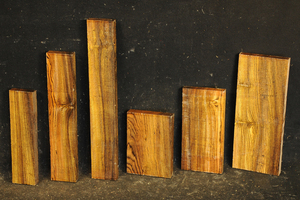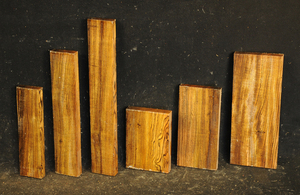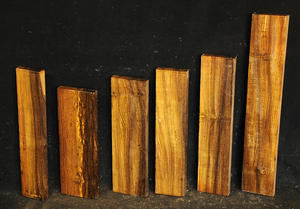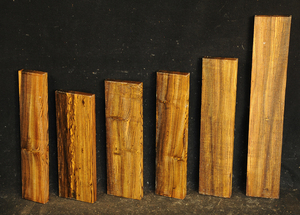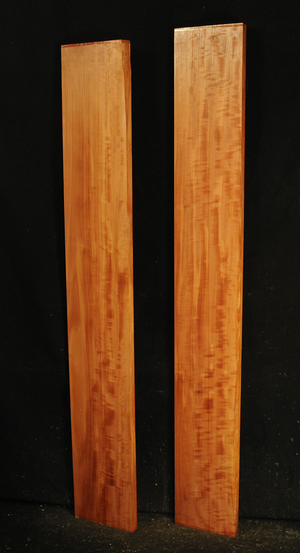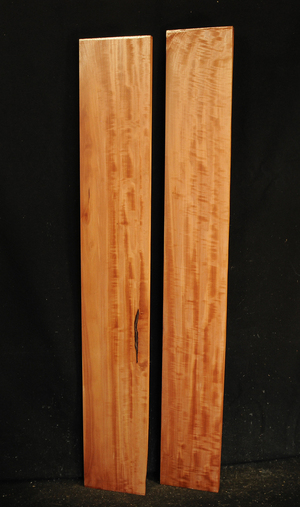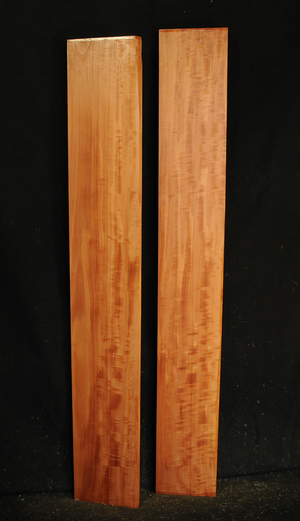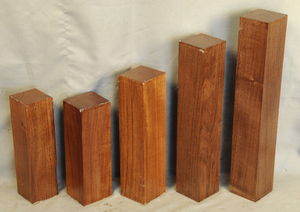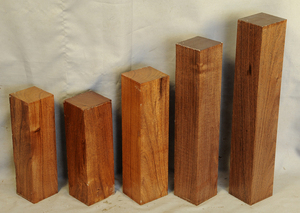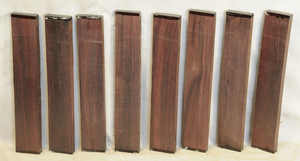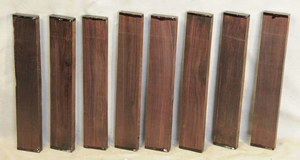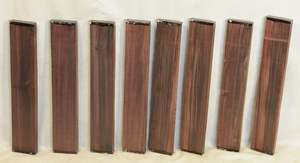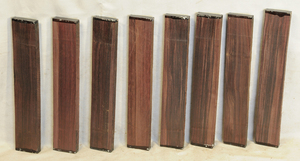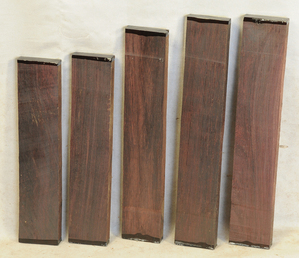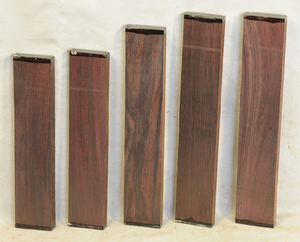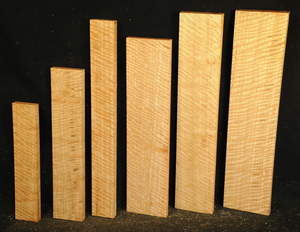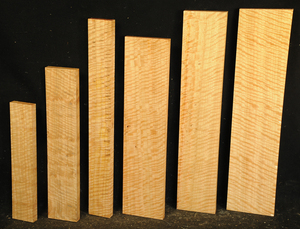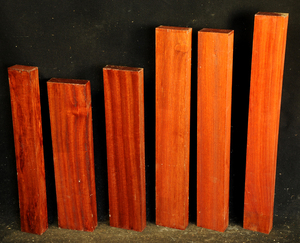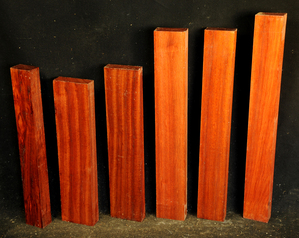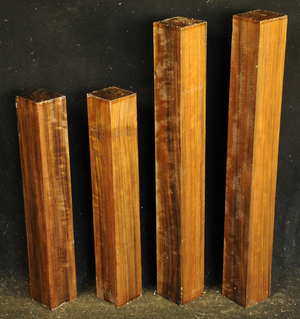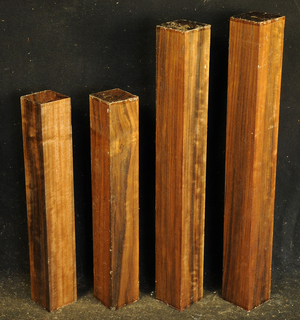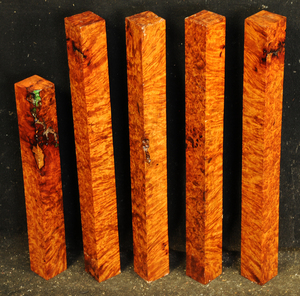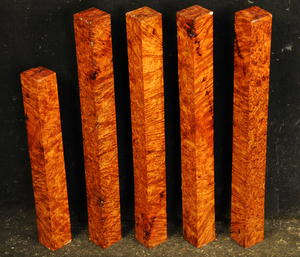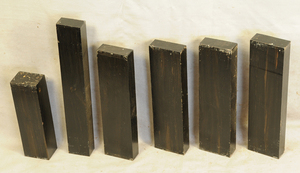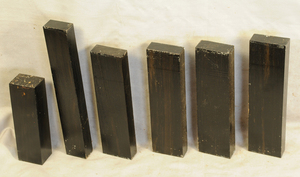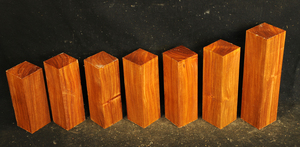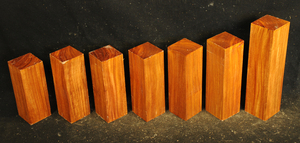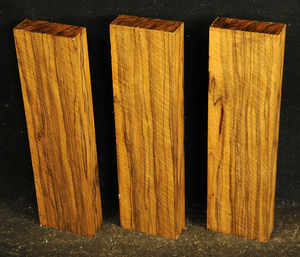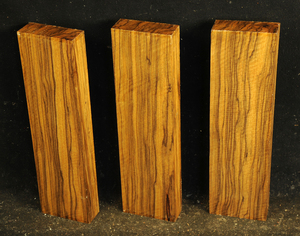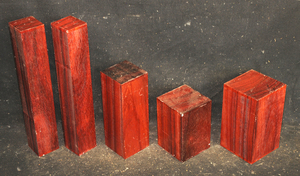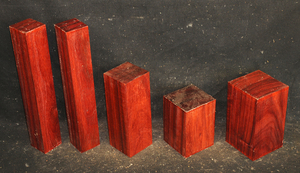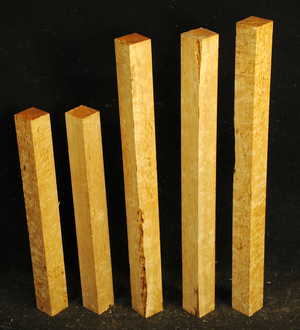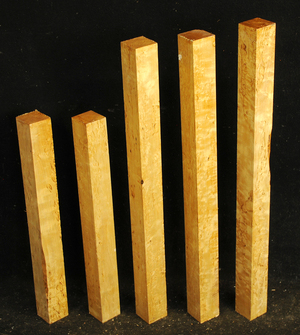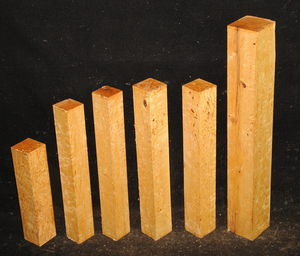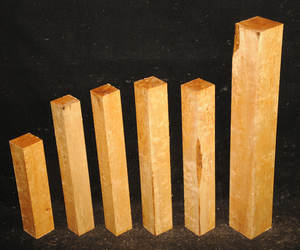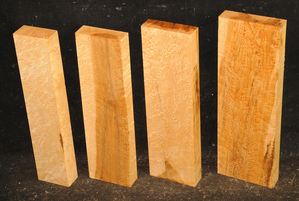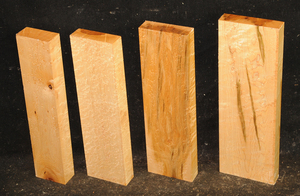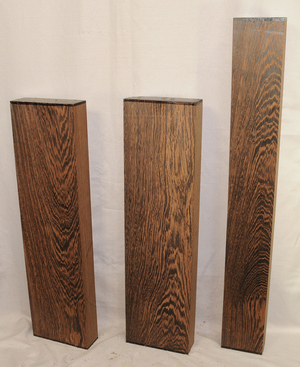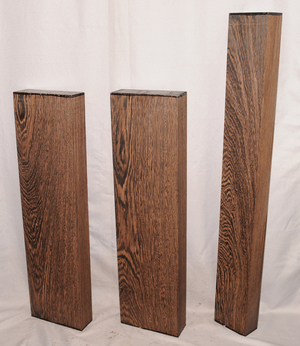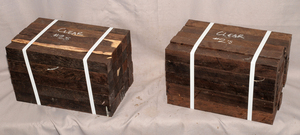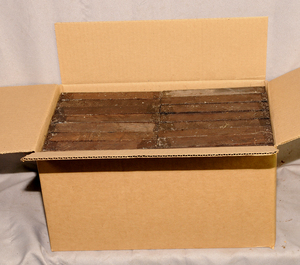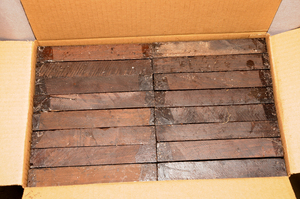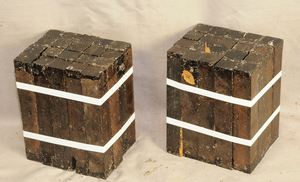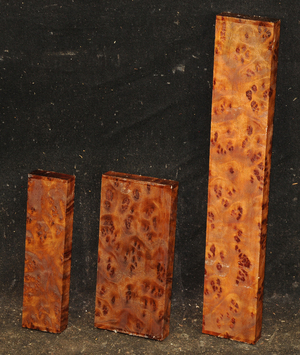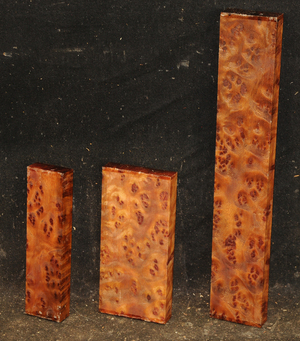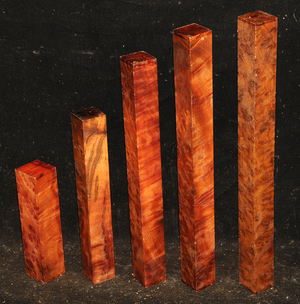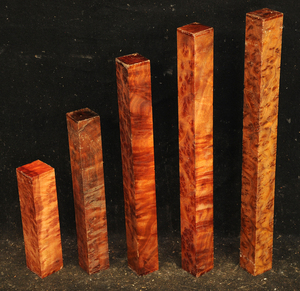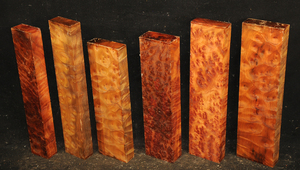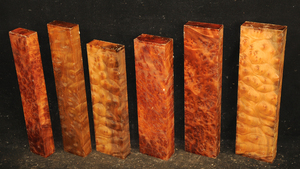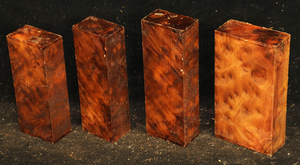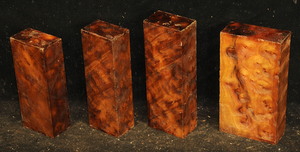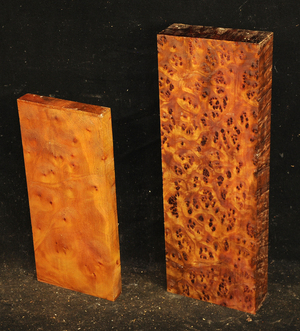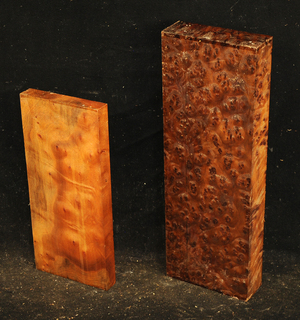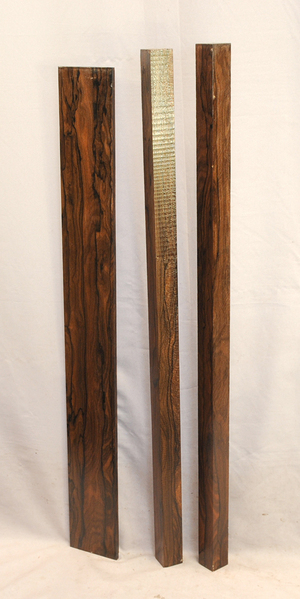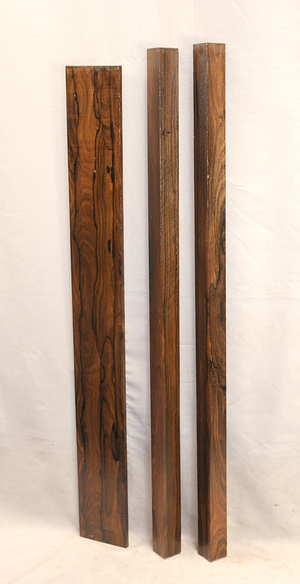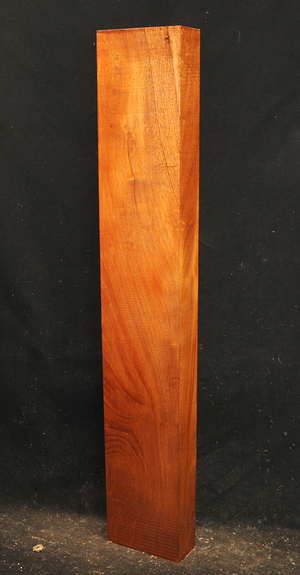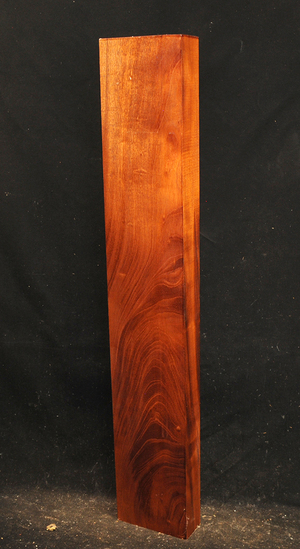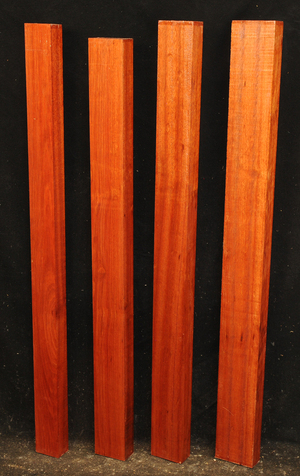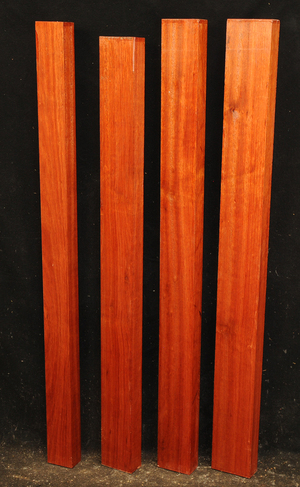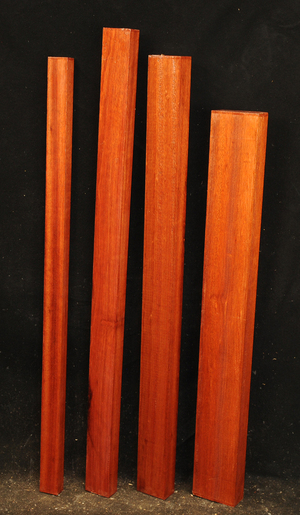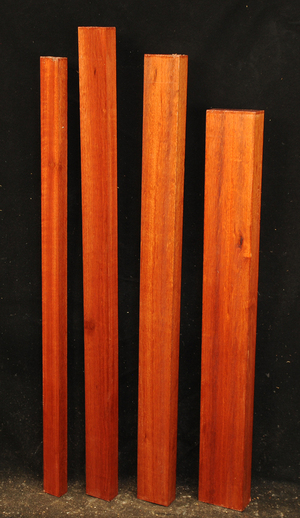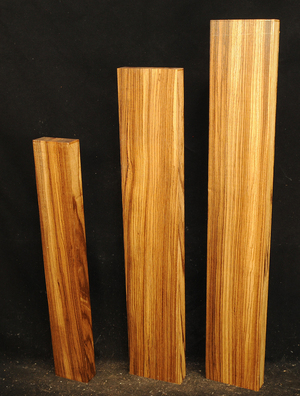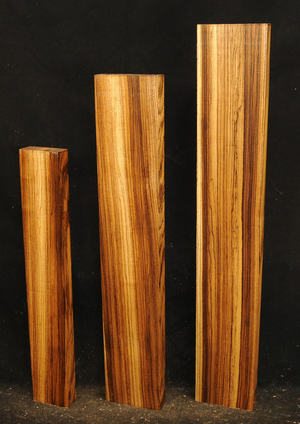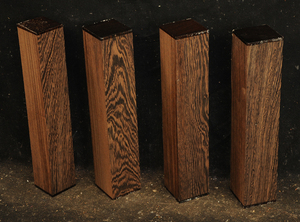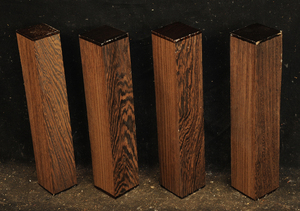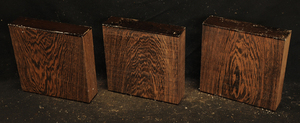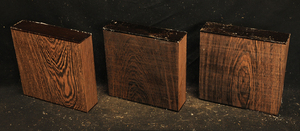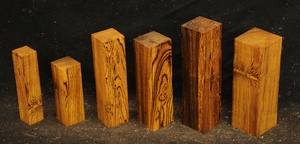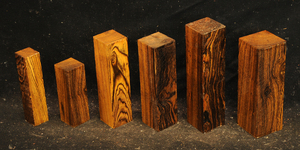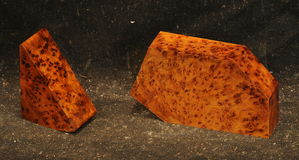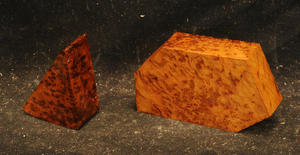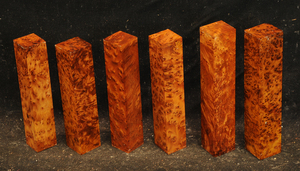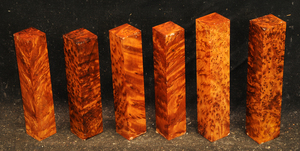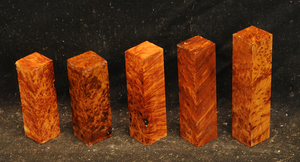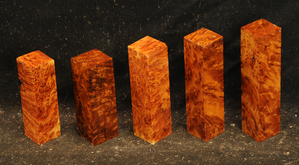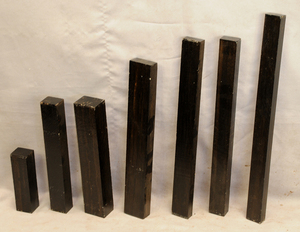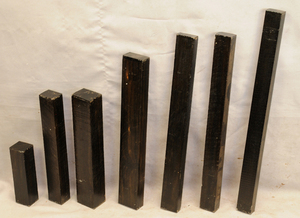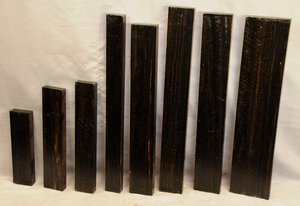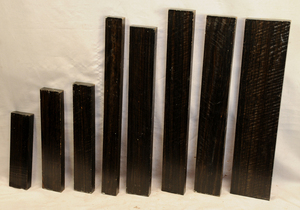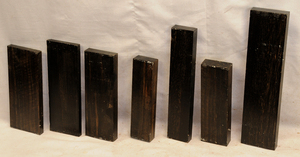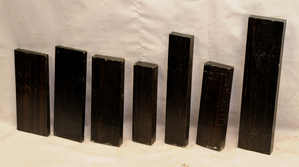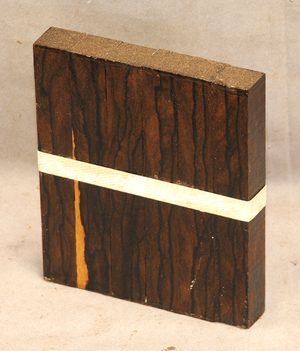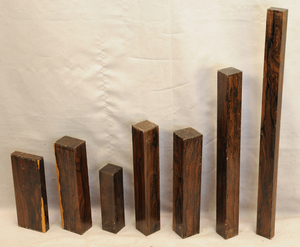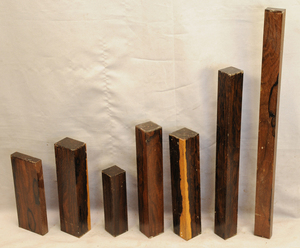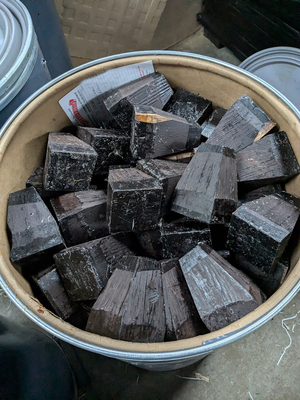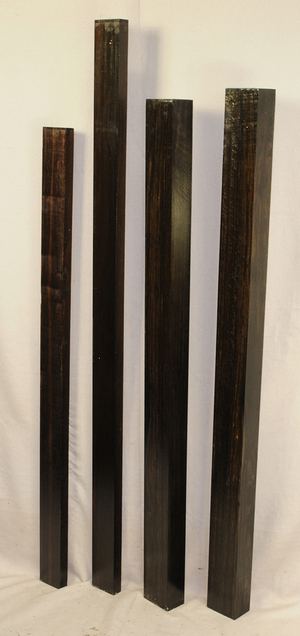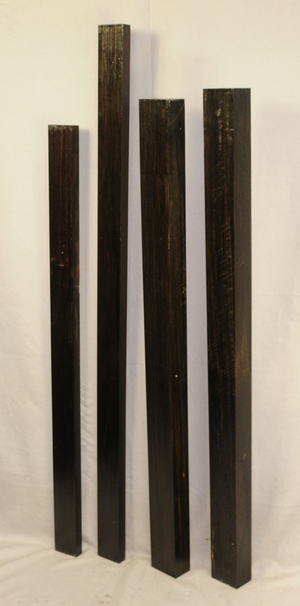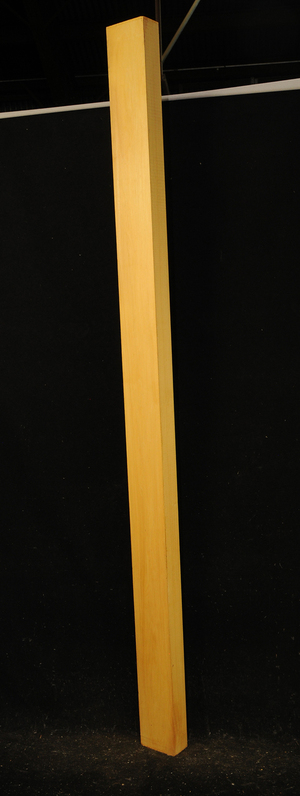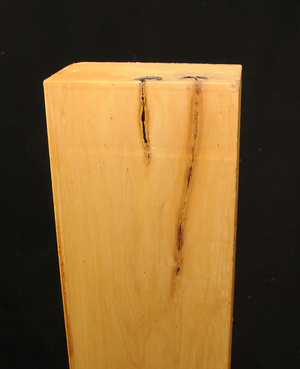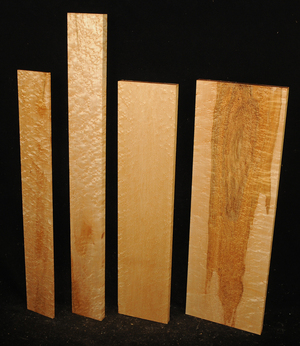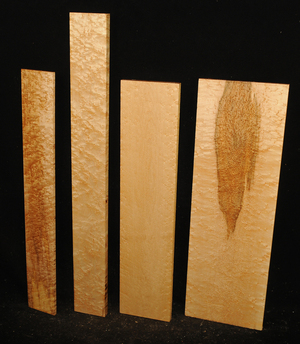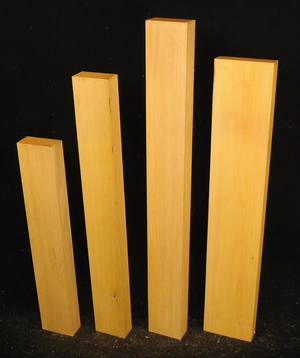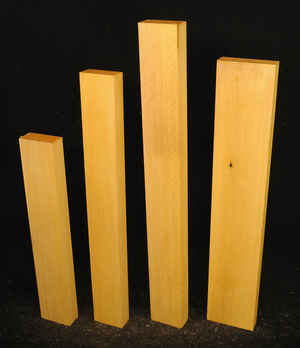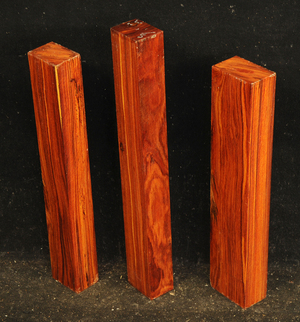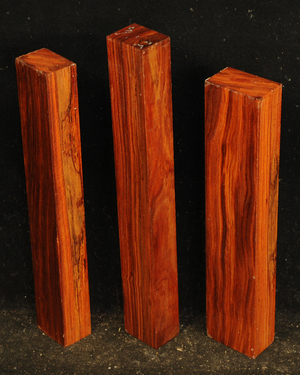Mexican Bocote
Calycophyllum multiflorum
Castello Boxwood, though not a true Buxus species, still has a very fine texture and a lovely light canary yellow color. This is truly a dream wood to mill.It is an excellent turnery wood, capable of very fine detail. Also very popular for making scale timbers and other parts for model ships. Air-dried.
Item Number: W43488
Mexican Bocote
Cordia elaeagnoides
Bocote is an oily wood with a yellowish to dark brown color accented with irregular black stripes and streaks. It has a spicy smell and is hard, heavy and strong. It is easy to work and takes a very nice polish. This beautiful wood is seldom seen in woodworker's shops.
Item Number: W43487
Figured European Pearwood
Pyrus communis
Almost all Pearwood imported into the U.S.A. has been steamed to bring out a more pinkish-red color and to prevent drying stresses. Formerly the wood was used for carving, turning, drawing instruments, wood engravings, textile printing blocks, and tool handles. Stained black it is an excellent substitute for Ebony. Contemporary uses include woodwinds such as recorders, furniture, kitchen accessories, jewelry and other boxes, and architectural uses such as paneling and doors.
Item Number: W43486
Black Mesquite Turning Squares
Prosopis nigra
A very few pieces of Mesquite are figured with what we call frog's-hair curl, a small, tight curl with as many as 12-15 curls per inch. A very stable wood. Air-dried.
Item Number: W43483
Bois de Rose
Dalbergia maritima
Bois de Rose is a true rosewood from Madagascar and is little known on the world timber market. It is a deep burgundy color, sometimes with darker striping and darkens on exposure. It is hard and heavy and takes a high, glassy- smooth polish. This wood has a tap tone more like old Brazilian Rosewood than any other species we have cut. Bois de Rose is one of the rarest in the rosewood family. We have a very limited stock of this beautiful wood and when it is gone we will not be able to replace it. Air dried.
Due to CITES regulations, we can only ship this species to customers in the United States.
Item Number: W43482
Bois de Rose
Dalbergia maritima
Bois de Rose is a true rosewood from Madagascar and is little known on the world timber market. It is a deep burgundy color, sometimes with darker striping and darkens on exposure. It is hard and heavy and takes a high, glassy- smooth polish. This wood has a tap tone more like old Brazilian Rosewood than any other species we have cut. Bois de Rose is one of the rarest in the rosewood family. We have a very limited stock of this beautiful wood and when it is gone we will not be able to replace it. Air dried.
Due to CITES regulations, we can only ship this species to customers in the United States.
Item Number: W43481
Bois de Rose
Dalbergia maritima
Bois de Rose is a true rosewood from Madagascar and is little known on the world timber market. It is a deep burgundy color, sometimes with darker striping and darkens on exposure. It is hard and heavy and takes a high, glassy- smooth polish. This wood has a tap tone more like old Brazilian Rosewood than any other species we have cut. Bois de Rose is one of the rarest in the rosewood family. We have a very limited stock of this beautiful wood and when it is gone we will not be able to replace it. Air dried.
Due to CITES regulations, we can only ship this species to customers in the United States.
Item Number: W43480
Figured Eucalyptus
Item Number: W43479
Bloodwood
Brosimum paraense
Also called Satine, Cacique, and Cardinalwood. The heartwood is a rich strawberry red, in sharp contrast to the light colored sapwood. Takes a high, lustrous finish.
Item Number: W43477
Figured Shedua Turning Squares
Guibourtia sp.
Also called Ovangkol and Amazakoue. This wood is increasingly becoming popular as an acoustic guitar wood. The color varies from a rich, golden brown to a lustrous grayish brown usually with a black stripe.
Item Number: W43476
Amboyna Burl Turning Squares/Pool Cue Blanks
Pterocarpus indicus
One of the world's most rare and beautiful burls. A light to deep reddish-orange, sometimes with darker lines, and with a lovely, spicy scent, there is hardly an area not highly figured with bird's-eyes. Hard & heavy and capable of taking a fine polish.
A is only tallied at 9" long due to some defects at one end.
B is only tallied at 14 1/4" due to a defects at one end.
Item Number: W43471
West African Ebony
Diospyros crassiflora
Sometimes called Gabon or Gaboon, this Ebony is sometimes jet black but oftentimes has grayish streaks that mostly disappear when finished or after the made object has been put into service. This Ebony has a marked resistance to checking that is characteristic of some of the Indian and Asian species. It has a wonderful texture and is easily carved, planed, turned, and milled. It is fairly fine-grained and takes a high polish. This Ebony usually originates in either Cameroon or Nigeria and the logs are rough hewn in the forest and oftentimes brought to the nearest road by human porters. With the disappearance of other species of black Ebony this species is fast becoming the Ebony of choice.
Item Number: W43469
Narra Turning Squares
Pterocarpus indicus
Also called New Guinea Rosewood. It is a beautiful, highly lustrous golden yellow color sometimes with reddish streaks. A nice turning wood it is also used in furniture, jewelry boxes, handles, etc. It is easy to work and glue and takes a nice polish.
Item Number: W43467
Figured Black Limba
Terminalia superba
Beautifully variegated and colored, Black Limba is easy to work and finish. This wood is found in the equatorial forests of West Africa. Black Limba has wonderful tonal properties and is suitable for both solid-body guitars and acoustic guitars. Easy to work and takes a nice polish.
Item Number: W43466
Padouk Turning Squares
Pterocarpus soyauxii
This brick-red colored West African hardwood was once one of the more common imported hardwoods but has become increasingly scarce in the last couple of years. It is easy to work, takes a nice polish and is dimensionally stable.
Item Number: W43465
Masur Birch Turning Squares
Betula alba
Also called Alpine Burl or Karelian Burl after the Finnish province of Karelia where it is often found. The high figure found in this wood is caused when the tree heals the damage done by an invasive boring beetle. The beetle infestation leaves the trees stunted and sometimes deformed but produces wood with small twists and swirls that highlight the darker, burly figure. Rare.
Item Number: W43462
Masur Birch Turning Squares
Betula alba
Also called Alpine Burl or Karelian Burl after the Finnish province of Karelia where it is often found. The high figure found in this wood is caused when the tree heals the damage done by an invasive boring beetle. The beetle infestation leaves the trees stunted and sometimes deformed but produces wood with small twists and swirls that highlight the darker, burly figure. Rare.
Item Number: W43461
Bird's-eye Maple
Acer saccharum
The heartwood is white or cream to light brown or reddish brown. Figured somewhat like that of burl with many small eyes separate from each other. Hard and heavy, 45 lbs/cu ft. Easy to work and takes a smooth polish. U.S.A.
Item Number: W43460
Wenge
Millettia laurentii
Most Wenge comes from the interior of the Democratic Republic of the Congo (formerly Zaire), and is floated to market on the Congo river. It is fairly hard and heavy with a medium to coarse texture. The heartwood is very dark brown with fine, nearly parallel black veining. Very rich looking when finished.
Item Number: W43454
African Blackwood Turning Squares Bundles
Dalbergia melanoxylon
The heartwood is purplish to brownish-black with dark gray streaks giving an overall impression of being black. Lustrous with an attractive inner chatoyance. Very hard, heavy, close-grained, and virtually free from pores. Its stability and lovely tonal qualities make it an excellent instrument wood.
Due to CITES regulations, we can only ship this species to customers in the United States.
These bundles are for 25 Blackwood squares. While there may be a couple squares that are 1 3/8" square, most are at least 1 1/2". Most are at least 12" long as well.
These are mostly clear as well, with at most one tiny bug hole or a little grain abberation. Some sap corners that will mostly turn off. These are of better quality than the similar squares we sell in barrels or bags.
Item Number: OS102
African Blackwood Turning Squares Box
Dalbergia melanoxylon
The heartwood is purplish to brownish-black with dark gray streaks giving an overall impression of being black. Lustrous with an attractive inner chatoyance. Very hard, heavy, close-grained, and virtually free from pores. Its stability and lovely tonal qualities make it an excellent instrument wood.
Due to CITES regulations, we can only ship this species to customers in the United States.
This box contains 96 beautiful Blackwood squares. We bought these as #2's but they are quite nice with few defects. Would make great tool handles, knife scales, finials, etc.
The shipping on this box will be at most about $36.00, at least until UPS raises their rates again. This applies to orders in the contiguous 48 states.
Item Number: OS101
African Blackwood Turning Squares Bundles
Dalbergia melanoxylon
The heartwood is purplish to brownish-black with dark gray streaks giving an overall impression of being black. Lustrous with an attractive inner chatoyance. Very hard, heavy, close-grained, and virtually free from pores. Its stability and lovely tonal qualities make it an excellent instrument wood.
Due to CITES regulations, we can only ship this species to customers in the United States.
20 pieces of beautiful Blackwood squares. We bought these as #2's but they are quite nice with few defects. Would make great tool handles, knife scales, finials, etc.
Item Number: OS100
Camphor Burl
Cinnamomum sp.
This rare burl is from S.E. Asia and is seldom seen on the world market. It is fine-grained and varies in color from a light reddish-brown to almost scarlet. It is easy to work and has a very pungent, spicy scent. For a burl it is remarkably stable. Green to partially air dried.
Item Number: W43453
Camphor Burl Turning Squares
Cinnamomum sp.
This rare burl is from S.E. Asia and is seldom seen on the world market. It is fine-grained and varies in color from a light reddish-brown to almost scarlet. It is easy to work and has a very pungent, spicy scent. For a burl it is remarkably stable. Green to partially air dried.
Item Number: W43449
Camphor Burl
Cinnamomum sp.
This rare burl is from S.E. Asia and is seldom seen on the world market. It is fine-grained and varies in color from a light reddish-brown to almost scarlet. It is easy to work and has a very pungent, spicy scent. For a burl it is remarkably stable. Green to partially air dried.
Item Number: W43448
Camphor Burl
Cinnamomum sp.
This rare burl is from S.E. Asia and is seldom seen on the world market. It is fine-grained and varies in color from a light reddish-brown to almost scarlet. It is easy to work and has a very pungent, spicy scent. For a burl it is remarkably stable. Green to partially air dried.
Item Number: W43447
Camphor Burl
Cinnamomum sp.
This rare burl is from S.E. Asia and is seldom seen on the world market. It is fine-grained and varies in color from a light reddish-brown to almost scarlet. It is easy to work and has a very pungent, spicy scent. For a burl it is remarkably stable. Green to partially air dried.
Item Number: W43444
Ziricote Thin & Cane Blanks
Cordia dodecandra
Ziricote is another timber we get from the Yucatan Peninsula of Mexico. It is a lovely wood with a very pronounced ray fleck on radial surfaces sometimes producing a "landscape" effect much like picture jasper.
Item Number: W43440
Genuine Mahogany
Swietenia macrophylla
Also called Acajou, Tropical American Mahogany, and Honduras Mahogany. This medium to large tree occurs throughout Central and South America. Related to Cuban Mahogany (Swietenia mahogani) and Pacific Coast Mahogany (Swietenia humilis). It produces one of the classic furniture and cabinetmaking woods. The heartwood varies from a light reddish-brown to a rich, dark red. Generally straight grained and exceptionally stable, it is easy to machine, hand plane, sand and finish. Occasional logs produce several figures, curly, quilted, and the rare plum pudding figure which looks like large drips running down the board. Used in fine furniture and joinery, boat building, and in the guitar industry for acoustic sets and necks.
Due to CITES regulations, we can only ship this species to customers in the United States.
Item Number: W43438
Brazilian Bloodwood
Brosimum paraense
Also called Satine, Cacique, and Cardinalwood. The heartwood is a rich strawberry red, in sharp contrast to the light colored sapwood. Takes a high, lustrous finish.
Item Number: W43434
Brazilian Bloodwood
Brosimum paraense
Also called Satine, Cacique, and Cardinalwood. The heartwood is a rich strawberry red, in sharp contrast to the light colored sapwood. Takes a high, lustrous finish.
Item Number: W43433
Zebrawood
Microberlinia brazzavillensis
This striped wood develops a beautiful golden patina as it ages.
Item Number: W43431
Wenge Turning Squares
Millettia laurentii
Most Wenge comes from the interior of the Democratic Republic of the Congo (formerly Zaire), and is floated to market on the Congo river. It is fairly hard and heavy with a medium to coarse texture. The heartwood is very dark brown with fine, nearly parallel black veining. Very rich looking when finished.
Item Number: W43430
Wenge Bowl Blanks
Millettia laurentii
Most Wenge comes from the interior of the Democratic Republic of the Congo (formerly Zaire), and is floated to market on the Congo river. It is fairly hard and heavy with a medium to coarse texture. The heartwood is very dark brown with fine, nearly parallel black veining. Very rich looking when finished.
Item Number: W43429
Mexican Bocote Turning Squares
Cordia elaeagnoides
Bocote is an oily wood with a yellowish to dark brown color accented with irregular black stripes and streaks. It has a spicy smell and is hard, heavy and strong. It is easy to work and takes a very nice polish. This beautiful wood is seldom seen in woodworker's shops.
Item Number: W43427
Thuya Burl
Tetraclinis articulata
This comes from the Atlas mountains in Morocco and has a beautiful golden chatoyance. Its color varies from a rich, lustrous golden brown to nearly black. Thuya burl is hard and dense with a high oil content, but tends to be brittle. The eyes, perfectly round, are scattered about in some burls like the figure in bird's-eye maple; in others they are grouped as islands. Due to it's desert occurrence, the wood sometimes contains small defects or inclusions but most can be repaired with cyanoacrylate (super) glues. A rare species, this exquisite wood is used for inlays, small boxes, turnery, and precious objects.
Item Number: W43426
Thuya Burl Turning Squares
Tetraclinis articulata
This comes from the Atlas mountains in Morocco and has a beautiful golden chatoyance. Its color varies from a rich, lustrous golden brown to nearly black. Thuya burl is hard and dense with a high oil content, but tends to be brittle. The eyes, perfectly round, are scattered about in some burls like the figure in bird's-eye maple; in others they are grouped as islands. Due to it's desert occurrence, the wood sometimes contains small defects or inclusions but most can be repaired with cyanoacrylate (super) glues. A rare species, this exquisite wood is used for inlays, small boxes, turnery, and precious objects.
Item Number: W43425
Thuya Burl Turning Squares
Tetraclinis articulata
This comes from the Atlas mountains in Morocco and has a beautiful golden chatoyance. Its color varies from a rich, lustrous golden brown to nearly black. Thuya burl is hard and dense with a high oil content, but tends to be brittle. The eyes, perfectly round, are scattered about in some burls like the figure in bird's-eye maple; in others they are grouped as islands. Due to it's desert occurrence, the wood sometimes contains small defects or inclusions but most can be repaired with cyanoacrylate (super) glues. A rare species, this exquisite wood is used for inlays, small boxes, turnery, and precious objects.
Item Number: W43424
West African Ebony Thins
Diospyros crassiflora
Sometimes called Gabon or Gaboon, this Ebony is sometimes jet black but oftentimes has grayish streaks that mostly disappear when finished or after the made object has been put into service. This Ebony has a marked resistance to checking that is characteristic of some of the Indian and Asian species. It has a wonderful texture and is easily carved, planed, turned, and milled. It is fairly fine-grained and takes a high polish. This Ebony usually originates in either Cameroon or Nigeria and the logs are rough hewn in the forest and oftentimes brought to the nearest road by human porters. With the disappearance of other species of black Ebony this species is fast becoming the Ebony of choice.
Item Number: W43421
West African Ebony
Diospyros crassiflora
Sometimes called Gabon or Gaboon, this Ebony is sometimes jet black but oftentimes has grayish streaks that mostly disappear when finished or after the made object has been put into service. This Ebony has a marked resistance to checking that is characteristic of some of the Indian and Asian species. It has a wonderful texture and is easily carved, planed, turned, and milled. It is fairly fine-grained and takes a high polish. This Ebony usually originates in either Cameroon or Nigeria and the logs are rough hewn in the forest and oftentimes brought to the nearest road by human porters. With the disappearance of other species of black Ebony this species is fast becoming the Ebony of choice.
Item Number: W43419
West African Ebony
Diospyros crassiflora
Sometimes called Gabon or Gaboon, this Ebony is sometimes jet black but oftentimes has grayish streaks that mostly disappear when finished or after the made object has been put into service. This Ebony has a marked resistance to checking that is characteristic of some of the Indian and Asian species. It has a wonderful texture and is easily carved, planed, turned, and milled. It is fairly fine-grained and takes a high polish. This Ebony usually originates in either Cameroon or Nigeria and the logs are rough hewn in the forest and oftentimes brought to the nearest road by human porters. With the disappearance of other species of black Ebony this species is fast becoming the Ebony of choice.
Item Number: W43418
West African Ebony
Diospyros crassiflora
Sometimes called Gabon or Gaboon, this Ebony is sometimes jet black but oftentimes has grayish streaks that mostly disappear when finished or after the made object has been put into service. This Ebony has a marked resistance to checking that is characteristic of some of the Indian and Asian species. It has a wonderful texture and is easily carved, planed, turned, and milled. It is fairly fine-grained and takes a high polish. This Ebony usually originates in either Cameroon or Nigeria and the logs are rough hewn in the forest and oftentimes brought to the nearest road by human porters. With the disappearance of other species of black Ebony this species is fast becoming the Ebony of choice.
Item Number: W43417
Ziricote Pen Blanks Bundle
Cordia dodecandra
Ziricote is another timber we get from the Yucatan Peninsula of Mexico. It is a lovely wood with a very pronounced ray fleck on radial surfaces sometimes producing a "landscape" effect much like picture jasper.
6 pieces.
Item Number: W43416
Ziricote
Cordia dodecandra
Ziricote is another timber we get from the Yucatan Peninsula of Mexico. It is a lovely wood with a very pronounced ray fleck on radial surfaces sometimes producing a "landscape" effect much like picture jasper.
Item Number: W43415
African Blackwood Clarinet Bell Blank Barrel
Dalbergia melanoxylon
The heartwood of African Blackwood is purplish to brownish-black with dark gray streaks giving an overall impression of being black. Lustrous with an attractive inner chatoyance. Very hard, heavy, close-grained, and virtually free from pores. Its main use is in turning, and it claims the title of the finest of turnery woods, well known as the standard by which other turnery woods are judged. Long a favorite of ornamental turners, the nature of the wood allows very fine detail with sharp cutters, leaving a beautiful, burnished surface.
Some blanks may have sapwood corners or more, burly or wild grain, occasional bug holes, small inclusions, small checks, i.e. they have the small defects common to Blackwood. That said these have to be the best quality rejects I have seen in nearly 30 years. A good percentage have no discernible defects and those that do have minor ones.
They are an odd size to make it easier to turn the bell or flared end of a clarinet. On one end they are 2 3/4-3 1/4" square and the other end is 1 3/8-1 5/8" square with tapered sides as in the photo. Length is 4 3/4-5 1/4".
The barrel will ship via freight truck. Please call us if you have any questions. 503-274-1271
Due to CITES regulations, we can only ship this species to customers in the United States.
A has 196 pieces.
B has 196 pieces.
C has 198 pieces.
D has 195 pieces.
E has 193 pieces.
F has 195 pieces.
Item Number: W43414
West African Ebony
Diospyros crassiflora
Sometimes called Gabon or Gaboon, this Ebony is sometimes jet black but oftentimes has grayish streaks that mostly disappear when finished or after the made object has been put into service. This Ebony has a marked resistance to checking that is characteristic of some of the Indian and Asian species. It has a wonderful texture and is easily carved, planed, turned, and milled. It is fairly fine-grained and takes a high polish. This Ebony usually originates in either Cameroon or Nigeria and the logs are rough hewn in the forest and oftentimes brought to the nearest road by human porters. With the disappearance of other species of black Ebony this species is fast becoming the Ebony of choice.
Item Number: W43412
Castello Boxwood
Calycophyllum multiflorum
Castello Boxwood, though not a true Buxus species, still has a very fine texture and a lovely light canary yellow color. This is truly a dream wood to mill.It is an excellent turnery wood, capable of very fine detail. Also very popular for making scale timbers and other parts for model ships. Air-dried.
This board is actually 61 1/4" long but we tallied off the defect on one end.
Item Number: W43408
Bird's-eye Maple
Acer saccharum
The heartwood is white or cream to light brown or reddish brown. Figured somewhat like that of burl with many small eyes separate from each other. Hard and heavy, 45 lbs/cu ft. Easy to work and takes a smooth polish. U.S.A.
Item Number: W43407
Castello Boxwood
Calycophyllum multiflorum
Castello Boxwood, though not a true Buxus species, still has a very fine texture and a lovely light canary yellow color. This is truly a dream wood to mill.It is an excellent turnery wood, capable of very fine detail. Also very popular for making scale timbers and other parts for model ships. Air-dried.
A is figured.
C is figured.
Item Number: W43406
Pau Rosa
Swartzia fistuloides
Hard & heavy & capable of a beautiful polish. Rare on the American market. Partially air dried.
Item Number: W43401

